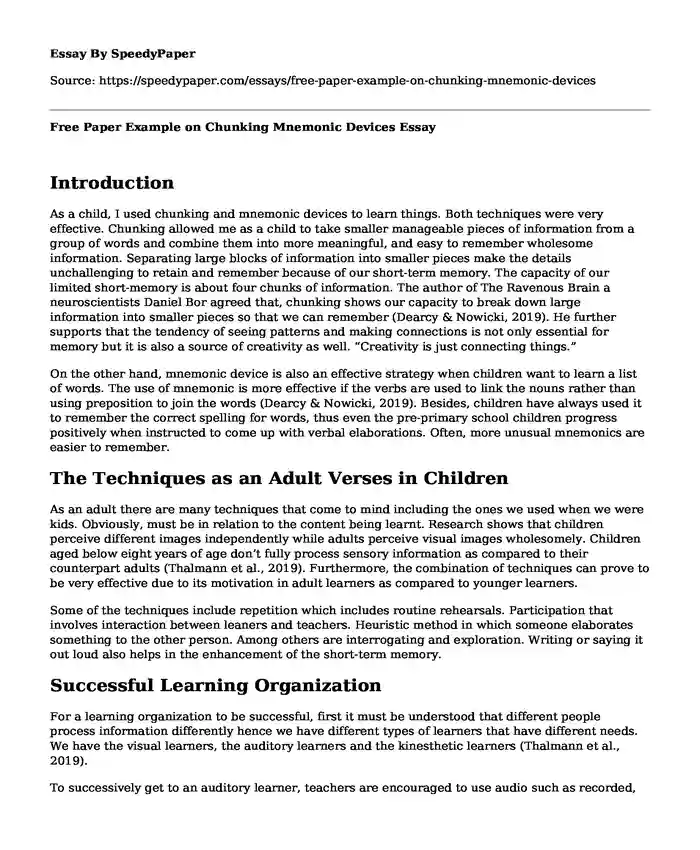
| Type of paper: | Essay |
| Categories: | Learning Students Child development Personal experience |
| Pages: | 3 |
| Wordcount: | 636 words |
Introduction
As a child, I used chunking and mnemonic devices to learn things. Both techniques were very effective. Chunking allowed me as a child to take smaller manageable pieces of information from a group of words and combine them into more meaningful, and easy to remember wholesome information. Separating large blocks of information into smaller pieces make the details unchallenging to retain and remember because of our short-term memory. The capacity of our limited short-memory is about four chunks of information. The author of The Ravenous Brain a neuroscientists Daniel Bor agreed that, chunking shows our capacity to break down large information into smaller pieces so that we can remember (Dearcy & Nowicki, 2019). He further supports that the tendency of seeing patterns and making connections is not only essential for memory but it is also a source of creativity as well. “Creativity is just connecting things.”
On the other hand, mnemonic device is also an effective strategy when children want to learn a list of words. The use of mnemonic is more effective if the verbs are used to link the nouns rather than using preposition to join the words (Dearcy & Nowicki, 2019). Besides, children have always used it to remember the correct spelling for words, thus even the pre-primary school children progress positively when instructed to come up with verbal elaborations. Often, more unusual mnemonics are easier to remember.
The Techniques as an Adult Verses in Children
As an adult there are many techniques that come to mind including the ones we used when we were kids. Obviously, must be in relation to the content being learnt. Research shows that children perceive different images independently while adults perceive visual images wholesomely. Children aged below eight years of age don’t fully process sensory information as compared to their counterpart adults (Thalmann et al., 2019). Furthermore, the combination of techniques can prove to be very effective due to its motivation in adult learners as compared to younger learners.
Some of the techniques include repetition which includes routine rehearsals. Participation that involves interaction between leaners and teachers. Heuristic method in which someone elaborates something to the other person. Among others are interrogating and exploration. Writing or saying it out loud also helps in the enhancement of the short-term memory.
Successful Learning Organization
For a learning organization to be successful, first it must be understood that different people process information differently hence we have different types of learners that have different needs. We have the visual learners, the auditory learners and the kinesthetic learners (Thalmann et al., 2019).
To successively get to an auditory learner, teachers are encouraged to use audio such as recorded, voice lessons that should be posted to the students’ website. Furthermore, group discussions should be encouraged, where students can explain to each other, as the learners get to understand more sound, recordings, music and rhymes.
Visual learners can learn much easily with visuals such as graphs, charts, diagrams, maps, pictures and videos (Thalmann et al., 2019). Visuals should therefore be made easily accessible to them, things like visual aids.
Students who prefer information presented in words. Should be presented with written materials such as text books, novels, magazines etcetera. It ensures they perform better in school.
Conclusion
Most people as it is, believe in what they see. Tours to areas related to learning should be made frequently. Practical lessons should also be increased. Besides, students must be encouraged to fuel their learning experience.
All in all, the learning culture must be instilled in students in any way possible. For knowledge is power.
References
Searcy, W. A., & Nowicki, S. (2019). Birdsong learning, avian cognition and the evolution of language. Animal Behaviour, 151, 217-227.
https://psycnet.apa.org/record/2019-10824-001
Thalmann, M., Souza, A. S., & Oberauer, K. (2019). How does chunking help working memory?. Journal of Experimental Psychology: Learning, Memory, and Cognition, 45(1), 37.
https://psycnet.apa.org/record/2018-18179-001.
Cite this page
Free Paper Example on Chunking Mnemonic Devices. (2023, Nov 24). Retrieved from https://speedypaper.net/essays/free-paper-example-on-chunking-mnemonic-devices
Request Removal
If you are the original author of this essay and no longer wish to have it published on the SpeedyPaper website, please click below to request its removal:
- Free Essay on Facilitating Change, Addressing Diversity, and Building the Community
- Free Essay with Text Analysis on Technology Impact on Learning
- Essay Example about Type A Personality
- Essay Sample on Personal Statement for Ph.D. in Chemistry
- Essay Sample on Pulmonary Function Tests
- Free Essay: Perception: Recognizing, Patterns and Objects
- Essay Sample on Maximus Masicus Visits the Orchestra
Popular categories




